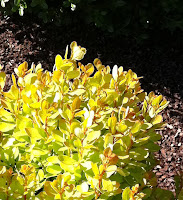New to the trade, retailers and landscapers are fired with enthusiasm about this tough and beautiful red-leaved shrub.
Named for the brilliant deep red gemstone, Garnet Fire(TM) Loropetalum is an ideally-sized evergreen shrub due to its outstanding, shiny, dark burgundy foliage. Colorful deep maroon-red leaves persist throughout the year in zones 7-11, and add a blaze of color to the winter landscape.
Known as Chinese Fringe Flower, hundreds of garnet-red, tassel-like flowers with narrow, fringe-like petals envelop the plant in late winter through spring. Individual flowers persist for weeks thus keeping the plant in bloom for months and beginning with sporadic flowering the previous fall. Honey bees appreciate the early pollen source and the flowers attract butterflies. Other common names for the genus Loropetalum include Chinese Loropetalum, Fringebush and Chinese Witch Hazel. Garnet Fire™ is a seedling selection of Loropetalum chinense 'Zuzhou Fuschia' originated by Ted Stephens who is a member of the Garden Debut(R) consortium of breeders, growers, retailers and marketers.
The multi-faceted, luminous shrub reaches a useful 4-5 feet in height and tolerates direct sun to part shade for versatile landscape placement. Use Garnet Fire (TM) as a specimen or accent plant, in the border, in front of the foundation plantings, as a container plant, for massing or as a screen. It is striking when planted next to pastel flowers, or beside yellow- or silvery- blue foliage that emphasize the burgundy foliage. Garnet Fire (TM) Loropetalum is a a tough plant that tolerates heat, humidity, deer, rabbits and slopes.
Traditionally, garnets were popular as a talisman and protective stone believed to light up the night and protect their bearers from harm. Like its namesake, Garnet Fire(TM) Loropetalum lights up the garden and protects the landscape from the monotony of too many green shrubs. Anyone who loves what is pure, natural and having the deep color of garnets will be fired with enthusiasm for Garnet Fire(TM) Loropetalum.
Statistics Chart for Garnet Fire™ Loropetalum, Loropetalum chinense var. rubrum ‘Garnet Fire’ PPAF
| Plant Category: | finely textured, broad leaf evergreen shrub |
| Mature Height: | 5-7 feet, or easily kept smaller with judicious pruning |
| Mature Spread: | 4-6 feet |
| Mature Form: | Rounded oval |
| Branching: | Branches arranged in layers |
| Growth Rate: | Moderate |
| Sun Exposure: | Versatile, direct sun to partial shade; Full sun (recommended) will bring out the stongest color, but light shade will help with drought resistance |
| Soil Type: | Sand, loam, clay; very adaptable |
| Soil Moisture: | Well-drained soils, dry to average, drought resistant once established |
| Flowers: | Garnet-red tassel flowers with fringe-like petals |
| Native origin: | Native to China and Japan |
| Foliage: | Evergreen shrub with dark maroon-red, burgundy leaves year round; beautiful, deep, rich maroon red coloring all year long |
| Fruit: | Inconspicuous black fruit in summer |
| Fall Color: | Leaves remain that gorgeous dark burgundy throughout fall and year-round. |
| Landscape Uses: | Garnet Fire(TM) Loropetalum is a tough plant that tolerates heat, humidity, deer, rabbits and slopes; use as specimen or accent plant, border, in front of the foundation planting, container, massing, screening, and striking when planted next to pastel flowers or yellow- or silvery- blue foliage plants to contrast with the burgundy foliage. |
| Root system : | Vigorous once established |
| pH Level: | 6.0 – 7.5 Garnet Fire™ does not appear to be very pH sensitive |
| Climate Zones: | 7 – 11, versatile and adds evergreen color across much of the U.S. |
| Heredity: | Ted Stephens, Nurseries Caroliniana in North Augusta, South Carolina |
Garden Debut® great new plants
# # #

.jpg)


















